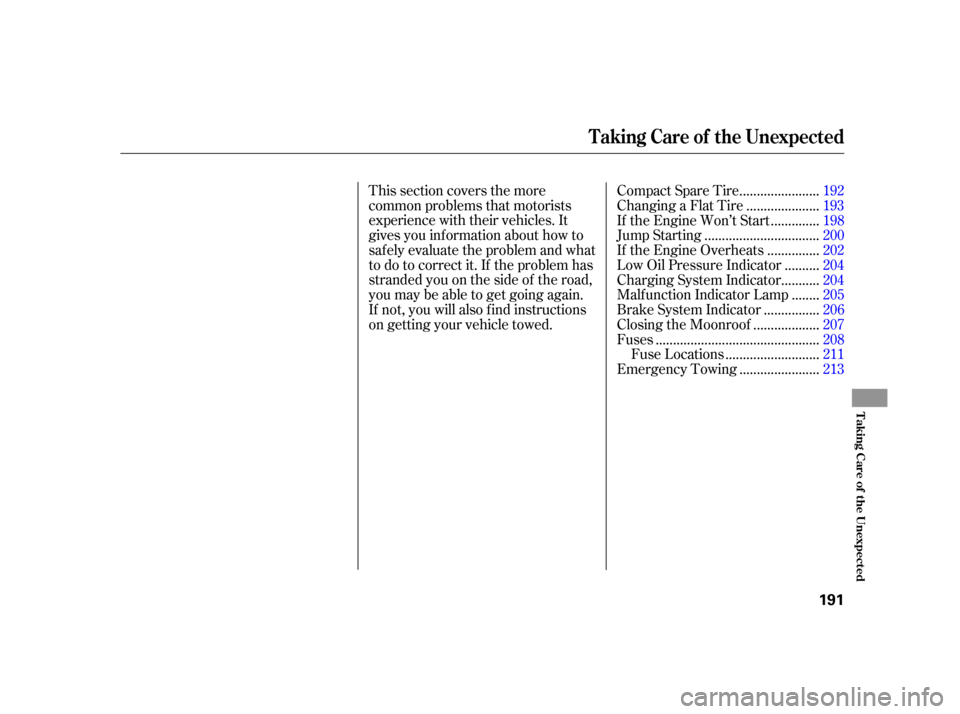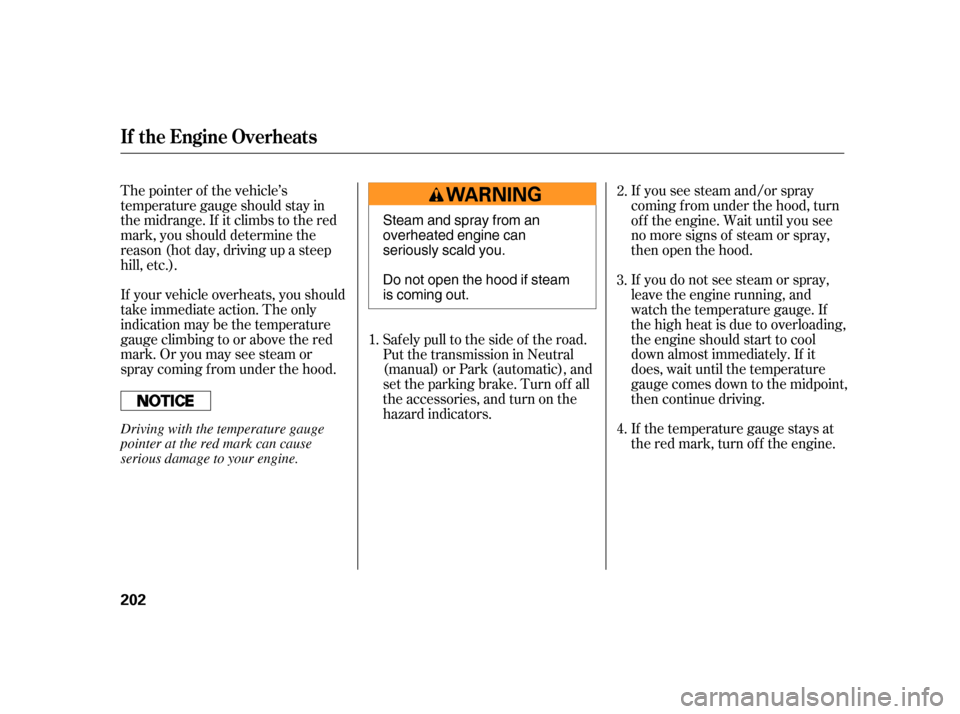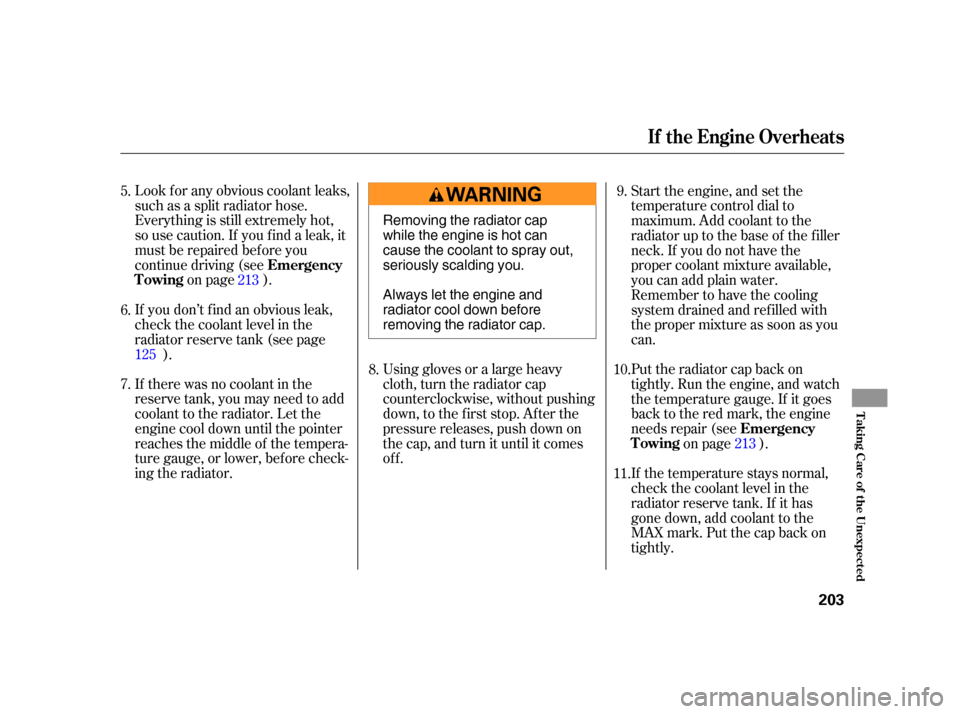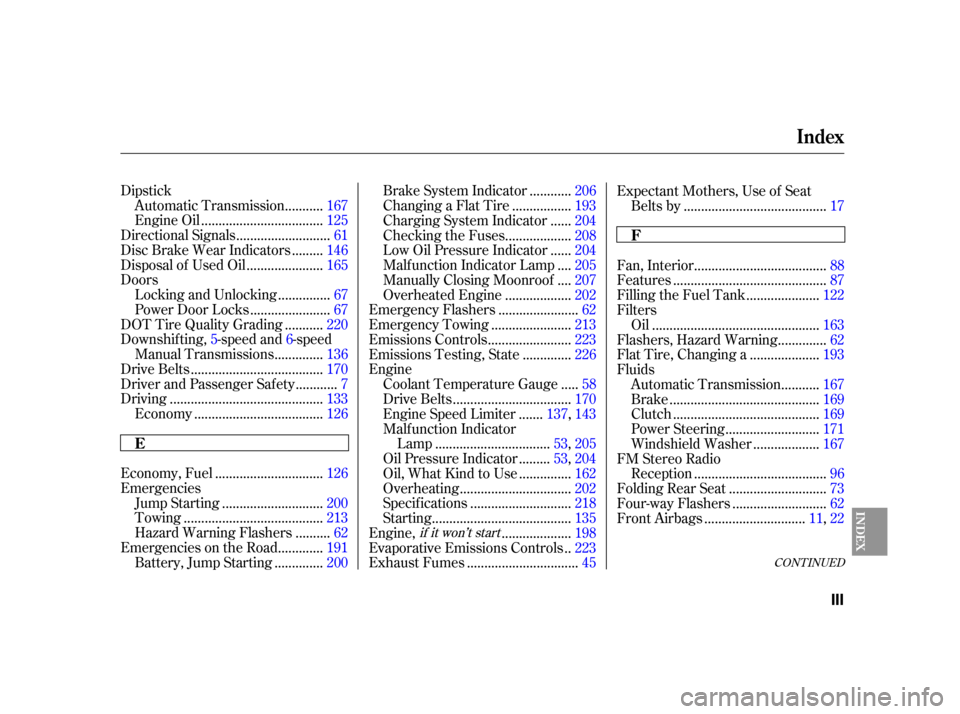engine overheat Acura RSX 2005 Owner's Manual
[x] Cancel search | Manufacturer: ACURA, Model Year: 2005, Model line: RSX, Model: Acura RSX 2005Pages: 243, PDF Size: 3.42 MB
Page 137 of 243

The manual transmission is syn-
chronizedinallforwardgearsfor
smooth operation. It has a lockout so
you cannot shift directly from Fifth
to Reverse. When shif ting up or
down,makesureyoupushtheclutch
pedal down all the way, shift to the
next gear, and let the pedal up
gradually. When you are not shif ting,
do not rest your f oot on the clutch
pedal. This can cause your clutch to
wear out faster.Come to a full stop before you shift
into Reverse. You can damage the
transmission by trying to shift into
Reverse with the vehicle moving.
Push down the clutch pedal, and
pause f or a f ew seconds bef ore
shif ting into Reverse, or shif t into
one of the f orward gears f or a
moment. This stops the gears so
they won’t ‘‘grind.’’
When slowing down, you can get
extra braking f rom the engine by
shifting to a lower gear. This extra
braking can help you maintain a safe
speed and prevent your brakes f rom
overheating while going down a
steep hill. Bef ore downshif ting,
make sure the engine speed will not
go into the tachometer’s red zone in
the lower gear.
Manual T ransmissions
136
Rapid slowing or speeding-up
can cause loss of control on
slippery surfaces. If you crash,
you can be injured.
Use extra care when driving on
slippery surfaces.
Page 153 of 243

If you must stop when f acing uphill,
use the f oot brake or parking brake.
Do not try to hold the vehicle in
placebypressingontheaccelerator,
as this can cause the automatic
transmission to overheat.
When driving down hills, reduce
your speed and shif t down to 2nd
gear (manual) or D (automatic). Do
not ‘‘ride’’ the brakes, and remember
it will take longer to slow down and
stop when towing a trailer.
Maketurnsmoreslowlyandwider
than normal. The trailer tracks a
smaller arc than your vehicle, and it
canhitorrunoversomethingthe
vehicle misses. Allow more time and
distance f or braking. Do not brake or
turn suddenly as this could cause the
trailer to jackknif e or turn over.
When climbing hills, closely watch
your temperature gauge. If it nears
the red (Hot) mark, turn the air
conditioning of f , reduce speed and, if
necessary, pull to the side of the
road to let the engine cool.
If the automatic transmission shif ts
f requently while going up a hill, shif t
to D .
Crosswinds and air turbulence
caused by passing trucks can disrupt
your steering and cause trailer
swaying. When being passed by a
large vehicle, keep a constant speed
and steer straight ahead. Do not try
to make quick steering or braking
corrections.Always drive slowly and have
someone guide you when backing up.
Grip the of the steering
wheel; then turn the wheel to the lef t
to get the trailer to move to the left,
andturnthewheelrighttomovethe
trailer to the right.
Follow all normal precautions when
parking, including f irmly setting the
parking brake and putting the
transmission in Park (automatic) or
in 1st or Reverse (manual). Also,
place wheel chocks at each of the
trailer’s tires.
3
3
bottom
Towing a Trailer
Making T urns and Braking Driving on Hills Handling Crosswinds and Buf f et ingBacking Up
Parking
152
Page 192 of 243

This section covers the more
common problems that motorists
experience with their vehicles. It
gives you inf ormation about how to
safely evaluate the problem and what
to do to correct it. If the problem has
stranded you on the side of the road,
you may be able to get going again.
If not, you will also f ind instructions
on getting your vehicle towed.......................
Compact Spare Tire .192
....................
Changing a Flat Tire .193
.............
If the Engine Won’t Start . 198
................................
Jump Starting .200
..............
If the Engine Overheats . 202
.........
Low Oil Pressure Indicator . 204
..........
Charging System Indicator . 204
.......
Malf unction Indicator Lamp . 205
...............
Brake System Indicator . 206
..................
Closing the Moonroof . 207
..............................................
Fuses .208
..........................
Fuse Locations .211
......................
Emergency Towing .213
Taking Care of the Unexpected
T aking Care of t he Unexpect ed
191
Page 203 of 243

The pointer of the vehicle’s
temperature gauge should stay in
the midrange. If it climbs to the red
mark, you should determine the
reason (hot day, driving up a steep
hill, etc.).If you see steam and/or spray
coming f rom under the hood, turn
of f the engine. Wait until you see
no more signs of steam or spray,
then open the hood.
If you do not see steam or spray,
leave the engine running, and
watch the temperature gauge. If
the high heat is due to overloading,
the engine should start to cool
down almost immediately. If it
does, wait until the temperature
gauge comes down to the midpoint,
then continue driving.
If the temperature gauge stays at
the red mark, turn of f the engine.
If your vehicle overheats, you should
take immediate action. The only
indicationmaybethetemperature
gauge climbing to or above the red
mark. Or you may see steam or
spray coming f rom under the hood.
Saf ely pull to the side of the road.
Put the transmission in Neutral
(manual) or Park (automatic), and
set the parking brake. Turn of f all
the accessories, and turn on the
hazard indicators.
1. 2.
3.
4.
If theEngineOverheats
202
Steam and spray from an
overheated engine can
seriously scald you.
Do not open the hood if steam
is coming out.
Driving with the temperature gauge
pointer at the red mark can cause
serious damage to your engine.
Page 204 of 243

Look f or any obvious coolant leaks,
such as a split radiator hose.
Everything is still extremely hot,
so use caution. If you f ind a leak, it
must be repaired bef ore you
continue driving (seeon page ).
If there was no coolant in the
reserve tank, you may need to add
coolant to the radiator. Let the
engine cool down until the pointer
reaches the middle of the tempera-
ture gauge, or lower, bef ore check-
ing the radiator. Using gloves or a large heavy
cloth, turn the radiator cap
counterclockwise, without pushing
down, to the f irst stop. Af ter the
pressure releases, push down on
the cap, and turn it until it comes
off.
Put the radiator cap back on
tightly. Run the engine, and watch
the temperature gauge. If it goes
back to the red mark, the engine
needs repair (see
on page ).
If the temperature stays normal,
check the coolant level in the
radiator reserve tank. If it has
gone down, add coolant to the
MAX mark. Put the cap back on
tightly.
If you don’t f ind an obvious leak,
check the coolant level in the
radiator reserve tank (see page
). Start the engine, and set the
temperature control dial to
maximum. Add coolant to the
radiator up to the base of the f iller
neck. If you do not have the
proper coolant mixture available,
you can add plain water.
Remember to have the cooling
system drained and ref illed with
the proper mixture as soon as you
can.
7. 8.9.
6. 5.
10.
11.
213
125
213
If theEngineOverheats
Emergency
Towing
Emergency
Towing
T aking Care of t he Unexpect ed
203
Removing the radiator cap
while the engine is hot can
cause the coolant to spray out,
seriously scalding you.
Always let the engine and
radiator cool down before
removing the radiator cap.
Page 236 of 243

CONT INUED
Dipstick..........
Automatic Transmission . 167
..................................
Engine Oil .125
..........................
Directional Signals .61
........
Disc Brake Wear Indicators . 146
.....................
Disposal of Used Oil .165
Doors ..............
Locking and Unlocking . 67
......................
Power Door Locks .67
..........
DOT Tire Quality Grading . 220
Downshif ting, 5-speed and6-speed
.............
Manual Transmissions . 136
.....................................
Drive Belts .170
...........
Driver and Passenger Safety . 7
...........................................
Driving .133
....................................
Economy .126
..............................
Economy, Fuel .126
Emergencies ............................
Jump Starting .200
.......................................
Towing .213
.........
Hazard Warning Flashers . 62
............
Emergencies on the Road . 191
.............
Battery, Jump Starting . 200 ...........
Brake System Indicator . 206
................
Changing a Flat Tire . 193
.....
Charging System Indicator . 204
..................
Checking the Fuses . 208
.....
Low Oil Pressure Indicator . 204
...
Malf unction Indicator Lamp . 205
...
Manually Closing Moonroof . 207
..................
Overheated Engine . 202
......................
Emergency Flashers .62
......................
Emergency Towing .213
.......................
Emissions Controls .223
.............
Emissions Testing, State . 226
Engine ....
Coolant Temperature Gauge . 58
.................................
Drive Belts .170
......
Engine Speed Limiter . 137,143
Malf unction Indicator ................................
Lamp .53, 205
........
Oil Pressure Indicator . 53,204
..............
Oil, What Kind to Use . 162
...............................
Overheating .202
............................
Specif ications .218
.......................................
Starting .135
...................
Engine, .198
.
Evaporative Emissions Controls . 223
...............................
Exhaust Fumes .45 Expectant Mothers, Use of Seat
........................................
Belts by .17
.....................................
Fan, Interior .88
...........................................
Features .87
....................
Filling the Fuel Tank . 122
Filters ...............................................
Oil .163
.............
Flashers, Hazard Warning . 62
...................
Flat Tire, Changing a . 193
Fluids ..........
Automatic Transmission . 167
..........................................
Brake .169
.........................................
Clutch .169
..........................
Power Steering .171
..................
Windshield Washer . 167
FM Stereo Radio .....................................
Reception .96
...........................
Folding Rear Seat .73
..........................
Four-way Flashers .62
............................
Front Airbags .11, 22
if it won’t start
Index
F
E
INDEX
III
Page 239 of 243

...................
Radiator Overheating . 202
...............
Radio/CD Sound System . 92
...........................
Readiness Codes .226
..
Rear Lights, Bulb Replacement . 177
............................
Rear Seat Access .72
..........................
Rear Seat, Folding .73
............................
Rear View Mirror .79
.................
Rear Window Def ogger . 62
....................
Rear Window Washer .60
.......................
Rear Window Wiper .60
...............
Reclining the Seat Backs . 71
.......
Recommended Shif t Speeds . 137
.......................
Reminder Indicators .52
.......................
Remote Transmitter .69
Replacement Inf ormation ..............
Dust and Pollen Filter . 179
................
Engine Oil and Filter . 163
.................................
Floor Mats .179
..........................................
Fuses .208
................................
Light Bulbs .172
....................................
Schedule .155
.....................................
Seat Belts .21
...........................................
Tires .186
.............................
Wiper Blades .180
...................
Neutral Gear Position . 140
..................
New Vehicle Break-in . 121
.....................
Normal Shif t Speeds .137
...................
NOTICE, Explanation of . i
...............
Numbers, Identif ication . 216
...
Octane Requirement, Gasoline . 121
.........................................
Odometer .57
...............................
Odometer, Trip .57
Oil ........................
Change, How to .163
......................
Change, When to .157
......................
Checking Engine .125
..............
Pressure Indicator . 53,204
Selecting Proper Viscosity ..............................
Chart .162, 163
...........
ON (Ignition Key Position) . 66
Onboard Ref ueling Vapor ....................................
Recovery .224
..............................
Outside Mirrors .80
....................
Overheating, Engine .202
.......
Owner Maintenance Checks . 156..............
Panel Brightness Control . 62
........................
Park Gear Position .140
...........................................
Parking .145
.................................
Parking Brake .81
Parking Brake and Brake .................
System Indicator . 53,206
........................
Parking Lights .61, 175
..
Parking Over Things that Burn . 145
............................
Playing the Radio .92
..................................
Playing a CD .101
..................
Playing a CD Changer . 103
.................................
Playing a Tape .98
.............................
PGM-FI System .224
..........................
Power Door Locks .67
.................
Power Socket Locations . 83
..............................
Power Windows .77
.........
Pregnancy, Using Seat Belts . 17
.........
Protecting Adults and Teens . 13
...
Additional Safety Precautions . 18
.....
Advice f or Pregnant Women . 17
........................
Protecting Children .28
.....................
General Guidelines .28
...........................
Protecting Inf ants .32
.............
Protecting Small Children . 33
Index
N
O PR
VI